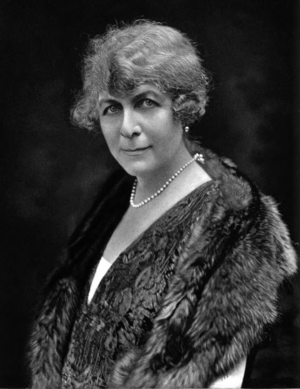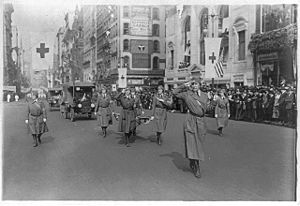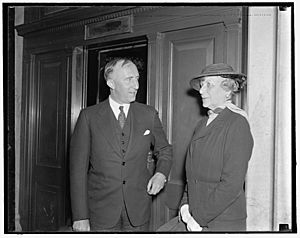Florence Jaffray Harriman facts for kids
Quick facts for kids
Florence Jaffray Harriman
|
|
|---|---|
 |
|
| 8th United States Minister to Norway | |
| In office July 1, 1937 – April 22, 1940 |
|
| President | Franklin D. Roosevelt |
| Preceded by | Anthony Drexel Biddle |
| Succeeded by | Anthony Drexel Biddle |
| Personal details | |
| Born |
Florence Jaffray Hurst
July 21, 1870 New York City, New York |
| Died | August 31, 1967 (aged 97) Georgetown, D.C. |
| Political party | Democratic |
| Spouses |
J. Borden Harriman
(m. 1889; |
| Children | Ethel Harriman |
| Profession | Suffragist Social reformer Diplomat |
Florence Jaffray "Daisy" Harriman (July 21, 1870 – August 31, 1967) was an American socialite, a supporter of women's right to vote, a social reformer, and a diplomat. She was known for being involved in many important historical events. For example, she led women's voting rights parades and worked to improve child labor laws. During World War II, as the U.S. Minister to Norway, she helped people escape the Nazi invasion.
In 1962, when she was 92 years old, President John F. Kennedy honored her. He gave her the first "Citation of Merit for Distinguished Service." She once said she always had "a box seat at the America of my times." This meant she was often right in the middle of history happening.
Contents
Early Life and Family
Florence Jaffray Hurst was born on July 21, 1870, in New York City. Her father, F. W. J. Hurst, was a wealthy shipping businessman. Her mother, Caroline, passed away when Florence was only three years old. Florence and her two sisters, Caroline and Ethel, were raised by their father and grandparents.
From a young age, Florence was around important people. When she was six, she watched her first political parade. She also listened to famous visitors at her home, like President James A. Garfield. Everyone knew her by her nickname, "Daisy."
Between 1880 and 1888, Daisy had private lessons at the home of a famous banker, J. P. Morgan. She also went to a girls' school. In 1889, at age 19, she married J. Borden Harriman, a New York banker. Many important people attended their wedding, including future President Grover Cleveland. Daisy and J. Borden Harriman had one daughter, Ethel Borden Harriman, born in 1897. Ethel later became an actress and writer in theater and movies.
A Social Leader and Helper
For many years, Florence Harriman was a well-known socialite. This meant she was active in high society and often attended important events. But she wasn't just interested in parties. She also cared deeply about helping others. Her life was split between her estate in Mount Kisco, New York, her home in New York City, and Newport, Rhode Island.
In 1903, she helped start the Colony Club in New York City. This was the first club in the city made just for women. Instead of only spending time with wealthy people, she reached out to others. For example, in 1908, she worked to show the harsh conditions in New York City factories. She believed that women who spent money should care about the welfare of women workers. In 1909, she even invited 100 members of a firemen's union to her summer home. This was unusual for a banker's wife at the time. In 1906, she was appointed to the board of a women's reformatory, a place for women who had broken the law.
Fighting for Rights and Change
Florence Harriman became a strong leader for people who didn't have many rights. She was very active in the women's suffrage movement. This movement worked to get women the right to vote. She even led a parade of women's voting rights supporters down Fifth Avenue. She also fought against unhealthy living conditions in crowded city buildings.
Franklin D. Roosevelt later said she was key to providing milk for poor children in New York City. In 1912, she actively supported Woodrow Wilson for president. She became the first president of the "Women's National Wilson and Marshall Association." She helped organize many meetings and mailings for his campaign.
When Wilson became president, he appointed Harriman to the first U.S. Commission on Industrial Relations. This group studied problems between workers and business owners. Harriman worked hard to find solutions.
World War I and Other Conflicts
In the summer of 1914, Florence Harriman, her husband, and daughter were in Europe when World War I started. They were hoping the waters in Karlsbad, a spa town, would help her husband's health. But then Austria-Hungary attacked Serbia, and the war began. They had to leave Karlsbad on the last train to France. They eventually returned to New York on a British ship. Sadly, her husband's health got worse, and he passed away on December 1, 1914.
The next year, Harriman found herself near another conflict. This was a battle in Mexico near the U.S. border. She visited the battlefields and helped care for the wounded.
Harriman became even more involved in charity work. She turned her Mount Kisco home into a hospital for people with tuberculosis. She also helped start the Committee of Mercy. This group helped women and children in Europe who were suffering because of the war. After the U.S. joined the war, she organized the American Red Cross Women's Motor Corps. She even directed the Women's Motor Corps in France.
Years of Public Service (1919-1937)
After World War I, Harriman attended the Versailles Peace Conference. She then worked to get the U.S. to join the League of Nations, an organization for world peace. Even after President Wilson left office in 1921, Harriman continued her political work. She became a member of the Democratic National Committee in 1920. She held this position for many decades. In 1922, she helped found the Woman's National Democratic Club and became its first president.
Her first book, "From Pinafores to Politics," was published in 1923. She was known for hosting "Sunday night salons" at her home in Washington, D.C. She would invite up to 32 guests with different opinions. They would discuss important issues, but everyone had to be polite and keep the conversations private.
During the Great Depression, Harriman lost most of her money. She had to earn income by decorating homes and working in real estate. She even shared her Washington home with paying guests, including Frances Perkins, the first woman to be a cabinet member. In 1932, she did not support Franklin D. Roosevelt for president at first. But after he was nominated, she quickly became one of his strongest supporters.
Diplomacy and World War II Efforts
In 1937, President Roosevelt appointed Harriman as the United States' Minister to Norway. Norway was one of the first countries to allow women to vote, so it was a good place for a woman diplomat. Her official title was "Envoy Extraordinary and Minister Plenipotentiary." She didn't know then how important this role would become during World War II.
In 1940, Germany suddenly invaded Norway. Harriman and other American officials had to flee with members of the Norwegian royal family. She helped arrange for the safety of other Americans and Norwegian royals, including Crown Princess Märtha and her children. She returned to the Nordic countries to help more U.S. citizens evacuate through Finland.
In January 1941, she left her position. She then worked to support the Lend-Lease Act, which helped the U.S. provide aid to its allies in the war. Her experiences in Norway became the subject of her book, "Mission to the North," published in 1941. In 1942, the King of Norway, Haakon VII of Norway, honored her with a special award.
After the U.S. entered World War II, Harriman continued to write. She wrote the foreword for one of the first English-language books about the the Holocaust and Auschwitz Concentration Camp. This book was published in 1944, before the camp was freed.
Fighting for Voting Rights in D.C.
Florence Harriman lived in Washington, D.C. for most of her life. Even though the Nineteenth Amendment to the United States Constitution gave women the right to vote in 1920, people in D.C. couldn't vote in presidential elections for many years. This meant she couldn't vote for president for decades.
In 1955, at age 84, Harriman led a parade in Washington, D.C. to protest this. She called it "taxation without representation," similar to the American Revolution slogan. She wrote a letter to The New York Times saying it was time for "another Boston tea party" to give D.C. residents voting rights.
In 1961, the Twenty-third Amendment to the United States Constitution was passed. This finally gave D.C. three electoral votes in presidential elections. So, in 1964, at age 94, Florence Harriman cast her very first vote in a presidential election. She voted for Lyndon B. Johnson. Even at 86, she continued to host dinners for many guests almost every Sunday night.
Death and Family
Florence Harriman passed away at her home in Georgetown, Washington, D.C., on August 31, 1967. Her daughter, Ethel, had passed away earlier in 1953.
Published Works
- Harriman, Florence Jaffray Hurst, Examples of Welfare Work in the Cotton Industry: Conditions and Progress : New England and the South, New York: Woman's Dept., National Civic Federation (1910)
- Harriman, Mrs. J. Borden, From Pinafores to Politics, New York: H. Holt and Company (1923)
- Harriman, Florence Jaffray, Mission to the North, Philadelphia: J.B. Lippincott (1941)
- Harriman, Florence Jaffray Hurst, Norway Does Not Yield; The Story of the First Year, New York: American Friends of German Freedom (1941)
- Zarembina, Natalia, and Harriman, Florence Jaffray Hurst, Oswiecim, Camp of Death (Underground Report), New York, N.Y.: "Poland fights," Polish Labor Group (1944)
- Harriman, Florence Jaffray Hurst, The Reminiscences of Mrs. Florence Jaffray Harriman (1972)





